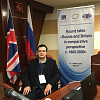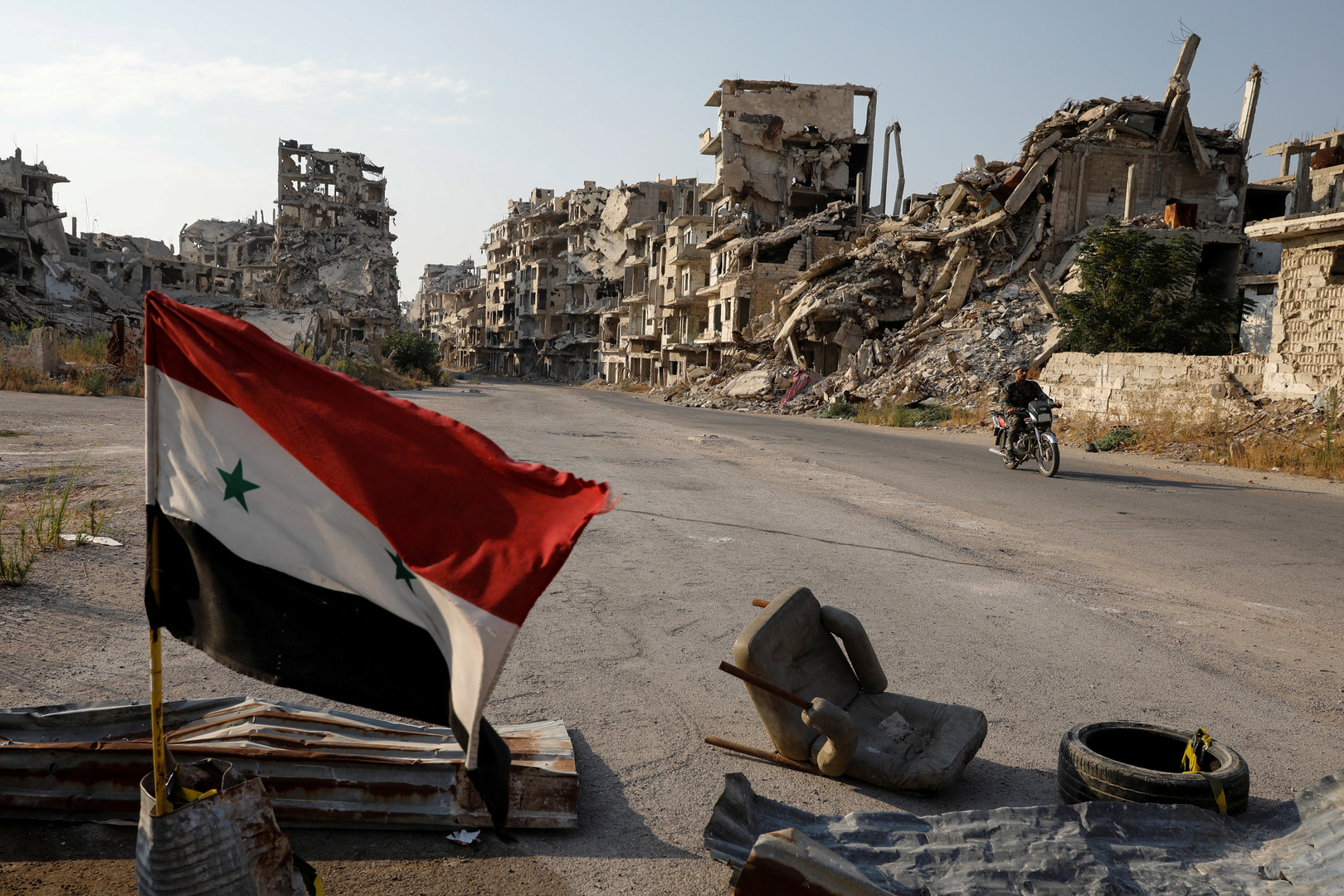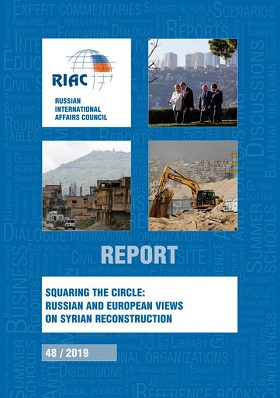From the beginning of the Syrian crisis, one of the most frequent comparisons used for the present situation is the Vietnam War. This is both by Arab government supporters, as a reminder of the most remarkable drubbing in recent history, as well as by US policymakers. The similarities range from the risk of third parties being involved in the conflict to the risk of public support (or dissent). A 2015 Guardian article alerted the American public of how "Syria [would have been] the next Vietnam-style war if Obama [had not] learned from history". The writers pointed out in the same piece how "Vietnam has shown the failure of an initial limited intervention to create political pressure for more aggressive action" and draws the conclusion that "US military power cannot compel democracy in foreign lands, neither can it force change among foreign populations".
In addition to reflecting a primarily isolationist position, typical of a continental political unity like the US with an oscillating international vocation, the profound message of the Guardian article was clearly more evocative to the American reader. The constraint to democracy of which they wrote (literally: compel [to] democracy), as well as the aforementioned limited intervention were a clear reference to the military strategy used by the US during the Cold War and put in place to counter the communist domino effect.
Of the strategy of compellence one can say that the “strategic code [...] is the anxiety for a feared damage, but which can still be avoided, as well as the temptation to escape from it when it is still possible to do so, the true 'solvent' of moral and political determination of the adversary to insist in his conduct”. A sequence of punctual, targeted, painful but not in itself decisive damages are those that, under the umbrella of nuclear danger, can be inflicted on the small ally of the major nuclear opponent. And the attacks on Syria, defined by Trump as a "mission accomplished", are exactly that. Of course, this change preserves the technological and substantial advancement in the military field of the unipolar era, including high precision weapons (which can lead to a higher application level of this type of strategy), but the basic approach has changed. What we have followed with apprehension in those days is the putting into practice of the contemporary diplomacy of violence exposed by the theorists of compellence. Those who had thought that a world challenge through proxy wars and the use of non-military means of war could have lasted forever did not realistically consider the instinct of self-preservation of the great political agglomerations. When the giants descend on the battlefields, and moreover they do so with the arsenals of mass destruction forged in the catastrophe of the Second World War, this means that we have gone too far. So long as the Western actor does not withdraw from his ambitions of international supremacy, or the Eastern one does not lay down his will to subsist (which is almost impossible given the aforementioned basic organic but also civilizational instinct of self-preservation), this is the conflictual model that we will see developing.
From the beginning of the Syrian crisis, one of the most frequent comparisons used for the present situation is the Vietnam War. This is both by Arab government supporters, as a reminder of the most remarkable drubbing in recent history, as well as by US policymakers[i]. The similarities range from the risk of third parties being involved in the conflict to the risk of public support (or dissent). A 2015 Guardian article alerted the American public of how "Syria [would have been] the next Vietnam-style war if Obama [had not] learned from history". The writers pointed out in the same piece how "Vietnam has shown the failure of an initial limited intervention to create political pressure for more aggressive action" and draws the conclusion that "US military power cannot compel democracy in foreign lands, neither can it force change among foreign populations[ii]".
In addition to reflecting a primarily isolationist position[iii], typical of a continental political unity like the US with an oscillating international vocation[iv], the profound message of the Guardian article was clearly more evocative to the American reader. The constraint to democracy of which they wrote (literally: compel [to] democracy), as well as the aforementioned limited intervention were a clear reference to the military strategy used by the US during the Cold War and put in place to counter the communist domino effect[v].
The Concept of Compellence
This military strategy, developed as a continuation of the American aviation doctrine of strategic bombing[vi], took the name of compellence[vii]. As Alexey Fenenko mentions, American experts used the term compellence to describe the transition from the old model of purely defensive deterrence to the new concept of offensive deterrence. Also defined as a way to conduct negotiations with arms, the military strategy of compellence is "understood as the art of employing military force in limited doses and in controlled forms in order to mold, through the effectively inflicted and especially the threatened costs, the conduct [...] of the other party[viii]”. Like deterrence[ix], compellence represents the strategic key-concept to understand the Cold War, more specifically understood as the bipolar phase of the balance of world powers. Practically, the US military doctrine appealed to these absolutely complementary concepts, practicing them in the world challenge to the Soviet bloc and in pursuing specific regional goals. According to Sergey Minasyan, coercive policy consists of two basic forms: defensive (deterrence) and offensive (compellence)[x].
If deterrence existed in consideration of the universally recognized principle of mutual assured destruction[xi], it expressed itself in the conflictual relationship at very low intensity between the two superpowers. This, as in the case of atoms with a lower state of thermal agitation, produced the cooling of conflict. The deterrence was, and still is, a valid principle in relation to the permanence of the nuclear threat, "characterized by an emphasis on rational decision making by top national leaders who are entrusted with the management of national security in a very dangerous world[xii]". The only alternative to the rationality of the decision-making processes of the White House and the Soviet Politburo would have been the irrationality of the war fought with the complete mass destruction weaponry. Alexey Arbatov points out that the strategic situation radically changed after 1960, when the Soviet Union achieved parity with the US. In 1967, after this change, Washington officially accepted the idea that any forecasts of a nuclear war should include unprecedented damage and devastation on American soil.
And yet, as we all know, the period of a bipolar world order was one of relative peace and enhanced development. The same goes for the current situation, as well as the Vietnam War, during which the strategy of compellence was developed. This type of strategy, as we have already said, applied to military aviation, provided for progressive dosage of bombardments on carefully selected enemy targets, so as to force them to bend their political will[xiii]. This type of action, however, was possible against those opposing forces which, in the context of the Cold War, were indeed representatives of the Eastern bloc, but not part of the Warsaw Pact. If, as put by Hegel, the world of ideas and doctrines always finds the technical means to develop and vice versa, these two parallel strategies (which in a sense made up the only American military doctrine during the Cold War) existed only as a function of the atomic weapon, which made its real use impracticable, and the greater precision of the bombers, which really permitted the destruction of the objectives necessary to put pressure on the enemy. This is an in the case of the modern concept of war of annihilation and the discovery of the war ends of gunpowder[xiv]. Nuclear deterrence during Cold War historically was closely related to the idea of strategic stability. Alexander Savelyev notes that this principle became the basis for the Treaty between the USA and the USSR on the elimination of their intermediate-range and shorter-range missiles of 1987, as well as the Strategic Arms Reduction Treaty of 1991[xv].
Anyway, this approach was soon surpassed both by the strong defeat in Indochina, after which the US visibly retreated to their home garden, and which led them to a rediscovery of the terricolous conceptions of the Clausewitzian polemological theories, making it lose sight of the independence of the aerial weapon, both by the implosion of the Soviet Union and the loss of the other great challenger of bipolarism, with the consequent transition to Western unipolarism (more or less perfect[xvi]). After the end of Cold War, the main threat to the survival of mankind, represented by an opportunity of the global nuclear war between the USSR and the USA, was practically overcome.
A New Era of US Domination
With this transition, the face of the war changed completely, and the new American strategies revolved more or less around the realization that the US had become an actor without real adversaries. We have been able to observe it in the two conflicts against Iraq. And although the game in Afghanistan remains open, the rediscovery of the invincibility of the partisans of the Earth[xvii] is not accompanied by their concrete possibility of victory. The military doctrine of unipolarism is therefore that that of the Overwhelming Force[xviii] (which in the name already seems to be an awareness of the world role of the US nowadays), where the extensive deployment of means is no longer a real problem.
Yet the events following the Ukrainian crisis have reintroduced an already creeping question in public debate about the reemergence of a bipolar conflict, like a second or never-ending Cold War[xix]. Although, for example, Feodor Voitolovsky suggests that the term New Cold War is a figure of speech and a significant exaggeration, since the current confrontation is a ‘vegetarian form’ of the original Cold War. If it is true that, apart from the unipolarity set by the US, the emerging players of the world economy and new political and strategic platforms are trying to ferry the world towards a multipolar structure, effectively exploiting a growing polycentricity also due to greater capital mobility and to the post-colonial phase of world history, it is also true that a strategic challenge between Russia-China (understood jointly within the Shanghai Cooperation Organization) and the United States is still in place[xx], easily readable under the spectrum of a new kind of bipolarity. According to the global forecast, published by Russian International Affairs Council in 2019, there is an opportunity for both scenarios of new multipolarity or new bipolarity. Multipolar scenario implies more independent role of Russia and China, as well as the growing independence of the European Union and the autonomy of India. Whereas neo-bipolar scenario implies intensification of China-US contradictions.
It is this kind of international scenario that can explain to us today the events of the last years on the Syrian chessboard of what is already, before everyone's eyes, a new way of setting the competition between states and political entities. If a multi-dimensional war is waged in Syria, what this means in concrete terms should be understood for good. More specifically, on the remains of the Arab country, in addition to (and above) different types of political and national interests and regional and ideological forces, these two major world forces are confronting, and this is demonstrated already by the joint Russian-Chinese involvement[xxi] in support of the Ba'athist government. While the Russian newscasts were preparing people for the possibility of a nuclear conflict[xxii], the world has radically changed the way war is waged. If the Syrian conflict was born as the most typical moment of the continuum of the fourth generation war[xxiii], with all its most evident elements, including the use of proxies and precisely multidimensionality[xxiv], the events of the night between 13th and 14th of April 2018 created a dialectical synthesis of the bipolar thesis and the unipolar antithesis of waging war, laying the foundations for a military doctrine not yet codified that we could call neo-compellence. According to Andrey Kokoshin, military strikes of the US and their allies against Syria on the 14th of April 2018 led to the conclusion that continuation of such actions would destabilize international relations. Negotiations on arms control, which previously were intensive, came to an end. This situation jeopardized the INF Treaty. It also made very unclear the perspectives of a prolongation of the New START Treaty after 2021[xxv].The bombings of US-led Western countries on alleged Syrian strategic objectives, carried out after an unnerving tug of war with the real competitor, i.e. the Russian Federation, and unexpectedly continued in the following days, without hitting the Russian armed forces, can be considered the manifesto of this new type of war, which precedes the eventual multi-polar transition. By and large, the Russian scientific community agrees with the thesis that the world order is in process of transformation from unipolar moment to the post-unipolar condition, but the terms to describe this new condition can be used different. For example, Alexander Dynkin prefers the discourse of polycentric world rather than multi-polar as more precise[xxvi].
Of the strategy of compellence one can say that the “strategic code [...] is the anxiety for a feared damage, but which can still be avoided, as well as the temptation to escape from it when it is still possible to do so, the true 'solvent' of moral and political determination of the adversary to insist in his conduct[xxvii]”. A sequence of punctual, targeted, painful but not in itself decisive damages are those that, under the umbrella of nuclear danger, can be inflicted on the small ally of the major nuclear opponent. And the attacks on Syria, defined by Trump as a "mission accomplished", are exactly that. Of course, this change preserves the technological and substantial advancement in the military field of the unipolar era, including high precision weapons (which can lead to a higher application level of this type of strategy), but the basic approach has changed. What we have followed with apprehension in those days is the putting into practice of the contemporary diplomacy of violence[xxviii] exposed by the theorists of compellence. Those who had thought that a world challenge through proxy wars and the use of non-military means of war could have lasted forever did not realistically consider the instinct of self-preservation of the great political agglomerations. When the giants descend on the battlefields, and moreover they do so with the arsenals of mass destruction forged in the catastrophe of the Second World War, this means that we have gone too far. So long as the Western actor does not withdraw from his ambitions of international supremacy, or the Eastern one does not lay down his will to subsist (which is almost impossible given the aforementioned basic organic but also civilizational instinct of self-preservation), this is the conflictual model that we will see developing.
[i] As in the case of the statement of the former Air Force Colonel and CNN military analyst C. Leighton, according to whom the Syrian conflict exceeds exponentially the one in Vietnam, evidently placing the two military crises on the same scale of intensity.
[ii] Ibid.
[iii] It was the epoch (on the rhetorical level, but today on the implementation level, USA willy-nilly) of America in retreat [cf. B. Stephens, America in Retreat. The New Isolationism and the Coming Global Disorder, Sentinel Books, 2014].
[iv] The geopolitical duplicity of the US according to Carlo Santoro [cfr. C. M. Santoro, La perla e l'ostrica. Alle fonti della politica globale degli Stati Uniti, Franco Angeli, 1986].
[v] Theory set out in 1954 by President Eisenhower [cf. E. E. Moise, The Domino Theory, in Encyclopedia of America Foreign Policy, Scribner's, 2002].
[vi] That modality of the Douhettian independent aerial strategy developed later by the school of thought of the US aviation and applied specifically in the Second World War [cfr. B. Liddell Hart, A History of the Second World War, Cassel and Co. Ltd., 1970]. The strategy, devised with the intent to limit the damage of the war, culminated however, coherently with the application premises, in the two atomic bombings on Japan.
[vii] T. Schelling, Arms and Influence, Yale University Press, 1966.
[viii] C. Stefanachi, 'Guerra Indolore'. Dottrine, illusioni e retoriche della guerra limitata, Vita & Pensiero, 2016, p. 163 (translated).
[ix] T. Schelling, op. cit.
[x] Минасян Сергей, «Силовая политика» в Карабахском конфликте: дихотомия сдерживания и принуждения // 21-й ВЕК, № 3 (23), 2012. С. 28.
[xi] But there were also those who, on the basis of the scientific studies in this regard, as Castro in his interventions for CubaDebate, stressed that in a nuclear conflict the assured destruction would not only be mutual, but absolute, planetary, of the species [cfr. Fidel Castro Ruz, L'inverno nucleare. Riflessioni sui rischi di una guerra atomica, Nemesis Edizioni, 2012].
[xii] R. Kolkowicz [edited by], Dilemmas of Nuclear Strategy, Frank Cass, 1987.
[xiii] R. A. Pape, Bombing to Win. Air Power and Coercion in War, Cornell University Press, 1996.
[xiv] Affirmation that shocked Popper so much [K. Popper, The Open Society and its Enemies, Princeton University Press, 2013].
[xv] Савельев А.Г., Стратегическая стабильность и ядерное сдерживание: уроки истории // Вестн. Моск. ун-та. Сер. 25: Международные отношения и мировая политика. 2015. № 3. С. 58.
[xvi] Cf. Kenneth Waltz's theories.
[xvii] To put it with Carl Schmitt [cf. C. Schmitt, Theory of the Partisan. Immediate Commentary on the Concept of the Political, Telos Press Pub., 2007].
[xviii] L. Middup, The Powell Doctrine and US Foreign Policy, Military Strategy and Operational Art, 2015.
[xix] Just google "new cold war" to get a general idea of the spread of this concept.
[xx] Z. Brzezinski, The Grand Chessboard: American Primacy and its Geostrategic Imperatives, Basic Books, 1997.
[xxi] In the case of China, its involvement was already evident in the role of obstruction to the Western intervention in the UN Security Council during the first accusations against President Assad, but it evidently materialized in the threatening movements of its naval units in April towards the theater of conflict and the public declaration of military support to Russia, already present in the territory, boot on the ground.
[xxii] I refer to the famous viral news of those days relaunched by all the agencies with the video of the TV show of Russian television that explained to citizens what food to bring in anti-atomic shelters in case of nuclear apocalypse.
[xxiii] L. Quiao and X. Wang, Guerra senza limiti. L'arte della guerra asimmetrica tra terrorismo e globalizzazione, Libreria Editrice Goriziana, 2016.
[xxiv] Which is more a broader perception of the phenomenon due to the more powerful means of information than a true result of post-modernity.
[xxv] Кокошин А.А., Стратегическая стабильность в условиях критического обострения международной обстановки // Полис. Политические исследования. 2018. № 4. С. 9.
[xxvi] Russia in Polycentric World (перевод с русск.) Eds. A.A. Dynkin and N.I. Ivanova. M., Ves Mir Publishers, 2012.
[xxvii] C. Stefanachi, op. cit., p. 164 (translation).
[xxviii] T. Schelling, op. cit.








